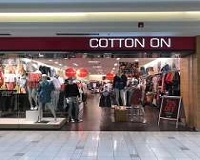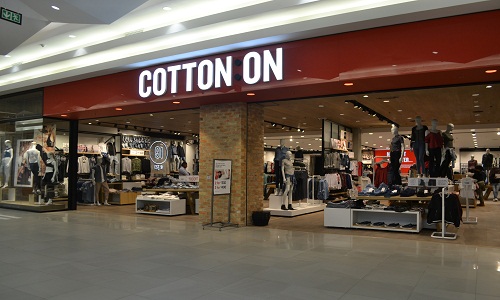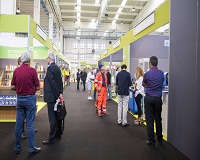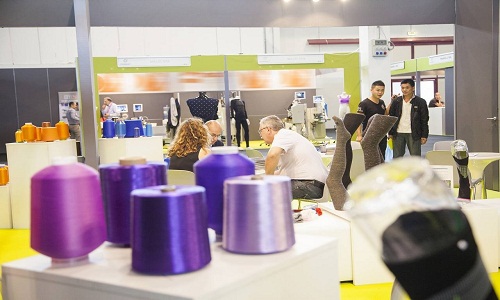FW
Denim is emerging from its purely masculine look to reveal more subtle and sensual fabrics with no gender attached. The result is high-end fabrications intended for tailored trousers, jackets and outerwear. There’s fluidity between fashion and denim. Whereas denim tends to dwell on the past—be it heritage work wear or nostalgic ’90s—the new season has shades of blue, novelty textures and a focus on how denim can adapt to its new niche market, including sport, street wear and evening.
Wool aspects can be visible such as natural-looking surfaces with irregular yarns or hidden as brushed wool on the inside of a jacket. Pinstripes, herringbones, Prince of Wales check and classic window pane patterns play up the tailoring story but are updated in blue.
To contrast, relaxed heavy denim inspired by street style is gaining momentum in the men’s and women’s categories. The trend is urban, graphic and inventive. Fabrications are made with thicker yarns to add softness and fullness to silhouettes. Nonchalant styling like cozy knits and cocoon-like shapes are key. Techniques that pump-up volume, such as smocking placed on shoulders to create an exaggerated ruffle, are made simply to surprise. Color blocking and contrast stitching add a youthful feeling.
India’s cotton yarn imports stabililsed at 2.77 per cent to around 3.2 million tonne in March 2018 as against 1.69 per cent in February 2018. Pakistan witnessed the highest growth in March 2018 with 32 per cent to reach 3.5 million tonne. China imported 2.34 million tonne in 2015, which was the peak of the over five years. And then declined in 2016 and 2017, its imports were both less than 2 million ton. In the first quarter of 2018, China imported 460,000 ton of cotton yarn, declining by 13.24 per cent year-on-year.
Imports for Vietnam also slowed during the period. The country’s imports had stabilised at 5.82 per cent in March from 3.38 per cent in February 2018. In terms of volumes, the country’s imports declined to 3.3 million ton in February 2018 from 6.8 million tonne in January 2018 and again increased to 5.8 million tonne in March 2018.
Global Fashion Group unit reported a buoyant quarter as revenue and customer numbers rose strongly, although the company remains loss-making on an ebitda basis. The ebitda loss widened a little and the margin was a negative 13.6 per cent, better than the minus 13.9 per cent of the prior year’s quarter. The number of active customers rose over 12 per cent.
The company’s group net revenue for the quarter was up 17.6 per cent on a constant currency pro forma basis but translating into 3.6 per cent growth in reported euro terms. Net Merchandise Value (NMV), which includes marketplace sales, grew 19.9 per cent on a constant currency basis, which was an acceleration on the equivalent period last year.
The 3.6 per cent sported rise meant that depreciation across all key currencies hurt topline euro growth with the Brazilian real, the Russian ruble and the Australian dollar being particularly problematic.
However, continued operational efficiency gains had a positive impact, even though the company’s investments in price at Dafiti, Zalora and The Iconic meant the gross profit margin declined by one percentage point year-on-year to 37 per cent. This impact was more than offset by path-to-profit initiatives and scale benefits.
Global Fashion Group is a part of Rocket Internet.
The Bangladesh envoy in Colombo has sought Sri Lankan collaboration in global apparel supply chain and logistics. The High Commissioner Riaz Hamidullah described Bangladesh’s vision and approach to multi-modal connectivity and outreach to South Asian region and beyond while addressing a special event on Bangladesh’s Journey in Development: Moving beyond LDC; and Perspectives on Regionalism at University of Colombo.
The event, organised with the Faculty of Graduate Studies at the Colombo University, commenced with a screening of a specially-tailored documentary highlighting key aspects of Bangladesh’s history, culture, geography and different facets of contemporary development.
In his 45-minute presentation, the high commissioner underlined inter alia the values and features of Bengali people and nationalism, people’s yearning for the values, Bangabandhu’s leadership in steering the War of Liberation. He summarised how Bangladesh’s development across the society and economy over the past four and half decades have come about in spite of various constraints and limitations.
The high commissioner also shared a number of Bangladesh’s developmental indigenous solutions and experience across sectors which are now replicated internationally.
Bangladesh is going to the International Labor Conference in Geneva with the draft copy of amended labor laws to satisfy the international community. The country has introduced changes to the draft of the labor law as per the recommendations of international communities like the ILO, the EU and the US to improve labor rights in the country.
Changes to the labor law have been brought in mainly in two areas. Now, an association of 20 per cent of the workers in a factory is sufficient to form an union instead of 30 per cent.
Second, officials of the Department of Inspection for Factories and Establishments would be able to visit and inspect the factories housed inside the Export Processing Zones. Previously this was not possible. With the current amended labor law that was adopted in July 2013 after the Rana Plaza building collapse, it was difficult to collect the consent of 30 per cent workers of a factory to form a trade union. Since then, only 625 trade unions have been formed in the garment sector, a paltry number.
As a result, the international community, particularly rights groups, lobbied to lower the threshold to a reasonable level so that unions can be formed easily. So 20 per cent was agreed to in consultation with the tripartite committee.
Yeşim Textile has earned the right to have internationally valid Authorized Economic Operator status. Yeşim Textile is the 228th company to obtain this document, thus proving its credibility by documenting that it fulfills the requirements of the legislation. This document, given to companies that have no adverse situation with respect to customs legislation and whose commercial records are reliable and traceable, offers a great advantage in speeding customs clearance.
The Authorised Economic Operator allows companies to easily control their own products and to make their transactions go faster. This document also provides the opportunity to make all customs transactions faster than other firms, reduce transaction costs and gain extra time. It also makes a positive contribution to the competitiveness of companies. Companies that can easily benefit from the privileges granted in countries where this certificate is valid are also beneficial in increasing cooperation with suppliers and reducing the uncertainties that may arise regarding shipments.
"New Zealand has come under the scanner of faking ‘Made in NZ’ tag when a leading media house did some checking. Stats show, New Zealand imported 10.6 million cotton T-shirts from Bangladesh last year, with an average value of $2.95 each. Outdoor clothing firm Macpac moved its manufacturing from Christchurch to China, Vietnam and the Philippines in 2003. As Nadia Scott, Marketing Manager, Macpac, says the brand had to take the decision to move production overseas when global demand for its products began to outstrip what it could supply with a New Zealand labour force. They took the time to research options and assess alternatives, and found manufacturing partners who are highly skilled. They can produce volumes that the company is unable to match in New Zealand with the limited availability of skilled machinists."
 New Zealand has come under the scanner of faking ‘Made in NZ’ tag when a leading media house did some checking. Stats show, New Zealand imported 10.6 million cotton T-shirts from Bangladesh last year, with an average value of $2.95 each. Outdoor clothing firm Macpac moved its manufacturing from Christchurch to China, Vietnam and the Philippines in 2003. As Nadia Scott, Marketing Manager, Macpac, says the brand had to take the decision to move production overseas when global demand for its products began to outstrip what it could supply with a New Zealand labour force. They took the time to research options and assess alternatives, and found manufacturing partners who are highly skilled. They can produce volumes that the company is unable to match in New Zealand with the limited availability of skilled machinists.
New Zealand has come under the scanner of faking ‘Made in NZ’ tag when a leading media house did some checking. Stats show, New Zealand imported 10.6 million cotton T-shirts from Bangladesh last year, with an average value of $2.95 each. Outdoor clothing firm Macpac moved its manufacturing from Christchurch to China, Vietnam and the Philippines in 2003. As Nadia Scott, Marketing Manager, Macpac, says the brand had to take the decision to move production overseas when global demand for its products began to outstrip what it could supply with a New Zealand labour force. They took the time to research options and assess alternatives, and found manufacturing partners who are highly skilled. They can produce volumes that the company is unable to match in New Zealand with the limited availability of skilled machinists.
Justifying the tag, she added most manufacturing companies work with or own factories around the world, often with plants in multiple countries, however the company identifies with the market where its products are designed, and where its senior management is based, driving the company's strategy and direction.
Fashion designer Dame Trelise Cooper points out her fashion brand had been manufacturing garments in New Zealand for 35 years. Currently, Trelise Cooper makes most samples and small volume runs in New Zealand. They employ multiple contractors throughout the Auckland region and employ 120 staff in New Zealand, many of whom make garments in-house, pattern making, cutting, machining and hand finishing. Around 54 per cent of its clothing was manufactured in China, 32 per cent in New Zealand, 11 per cent in India, 3 per cent in South Korea and 0.01 per cent in Bangladesh.
Cooper makes most samples and small volume runs in New Zealand. They employ multiple contractors throughout the Auckland region and employ 120 staff in New Zealand, many of whom make garments in-house, pattern making, cutting, machining and hand finishing. Around 54 per cent of its clothing was manufactured in China, 32 per cent in New Zealand, 11 per cent in India, 3 per cent in South Korea and 0.01 per cent in Bangladesh.
Similarly Icebreaker’s most clothing factories are located in China but it also has some in Bangladesh, Vietnam, America and Italy. Boutique fashion brand Ricochet said its garments were made in Auckland by its design and production team, with the exception of its knitwear which is produced in China. A Ricochet spokeswoman said the company bought production back to New Zealand in 2009 when it purchased the company from previous owners. Under previous ownership, production was based offshore, but after taking over the brand in 2009, it bought the production back to New Zealand. Since then, they manufacture everything in New Zealand except knitwear.
Many brands, similar opinions
Australian fashion company Cotton On’s clothing is made in Bangladesh and China since inception. Clothing sold at its other retail brands Cotton On Kids, Cotton on Body, Supré and Factorie is also made in Bangladesh and China. A spokeswoman for Karen Walker said its garments were produced in China and New Zealand. It has six ‘ready to wear’ suppliers in China, located in Shanghai, Suzhou, Wuxi and the Zhejiang province and one in Auckland. According to Karen Walker, marketing manager, Jiali Yang, the company’s suppliers are boutique-sized and have between one and 94 employees each. They deliver premium product in small runs as desired.
Yang said many brands who produced locally and used the ‘Made in New Zealand’ tags thought their systems were ethical but many did not know where their fabrics and add-ons came from. Over the past two years, they have traced all 11 fabric mills that supply fabric to them and the brand will continue to only work with fabric mills that are traceable. Its fabrics were produced in China, Italy, France, New Zealand, Japan and Korea and its suppliers were prohibited from sourcing fabric from stock markets.
Designer Annah Stretton said between 70 and 80 per cent of its clothing was made in China. The company took manufacturing to China in 2007 before that, they were a completely ‘Made in NZ’ brand. According to her, manufacturing cost in China are very similar to New Zealand, in fact they are sometimes higher given the volatility of the US dollar, so this wasn't a cost thing for her, it was an availability challenge that they had to solve.
Handbag company Deadly Ponies, which employs 42 local workers, said its accessories were designed in its Auckland workroom and around 60 per cent of its products were manufactured in New Zealand, ‘dependent on the season’, and the rest in France, India, China and Italy. Steven Boyd, MD, Deadly Ponies, stated that certain machines are not available in New Zealand and also production volume restrictions compelled them to move offshore. Boyd felt that it was fair for companies to promote themselves as local if its products were manufactured overseas.
"FIMAST, the much-awaited trade show for hosiery and knitting machinery, will be held from May 30 to June 2, 2018 at Brescia in Italy. The exhibition will showcase latest technological trends and ideas in the production of socks and hosiery throughout the supply chain. The show will be attended by most renowned manufacturers of socks and hosiery.Sina Filati, an Italian leader in high-quality yarns for the hosiery, knitwear and underwear segments, as well as for the seamless, weaving and ribbon industries will showcase products at the exhibiton. Nytex, an Italian yarn producer for hosiery and underwear will present a wide range of synthetic yarns at the exhibition. Founded in the 1960s, Nytex operates in both national and European textiles markets, combining Italian tradition and cutting-end technology."
 The upcoming months are likely to be busy for socks and hosiery manufacturers with numerous trade shows lined up.
The upcoming months are likely to be busy for socks and hosiery manufacturers with numerous trade shows lined up.
Trade shows to enhance business
FIMAST, the much-awaited trade show for hosiery and knitting machinery, will be held from May 30 to June 2, 2018 at Brescia in Italy. The exhibition will showcase latest technological trends and ideas in the production of socks and hosiery throughout the supply chain. The show will be attended by most renowned manufacturers of socks and hosiery.
Sina Filati, an Italian leader in high-quality yarns for the hosiery, knitwear and underwear segments, as well as for the seamless, weaving and ribbon industries will showcase products at the exhibiton. Nytex, an Italian yarn producer for hosiery and underwear will present a wide range of synthetic yarns at the exhibition. Founded in the 1960s, Nytex operates in both national and European textiles markets, combining Italian tradition and cutting-end technology.
Sandonini, an Italian company that reconditions and upgrades used socks, hosiery and seamless machines, will present its latest developments, including the 3D knitted shoe uppers, at the upcoming show. Ratti Luino, a textile machinery producer based in Varese, will present its latest innovations in twisting technology for natural silk, continuous artificial and synthetic filaments.
the 3D knitted shoe uppers, at the upcoming show. Ratti Luino, a textile machinery producer based in Varese, will present its latest innovations in twisting technology for natural silk, continuous artificial and synthetic filaments.
Unique experiences
Other show organisers are also gearing up to offer visitors unique industry experience. For instance, London’s biggest festival of fashion, Pure London, has collaborated with Thea Speechley to fast track the show’s sourcing and manufacturing section Pure Origin. Held at Olympia London alongside Pure London and Pure Man, will host over 70 manufacturers from the UK and around the world.
Eurovet is launching an ambitious programme at Unique by Mode City in Paris from July 7 to 9, 2018 under Paris-Moscow Express, designed for Russian buyers and brands interested in these markets.
Driven by strong spending on part of its consumers, apparel retailer Urban Outfitters Inc reported first-quarter profit and sales that handily beat analysts’ estimates.
Offering fewer discounts as well as investing more on its website helped the company boost its sales and margins which rose to 32.8 percent from 31.5 percent a year earlier.
All brands under the Urban Outfitter umbrella, including Anthropologie and Free People, posted better-than-expected same-store sales growth in the quarter ended April 30.
According to Thomson Reuters I/B/E/S, sales at stores open at least a year rose by 10 percent in the first quarter, beating analysts expectations for a 8.8 percent rise. Its net income rose to $41.3 million, or 38 cents per share, in the quarter ended April 30, from $11.9 million. Excluding items, the company earned 38 cents per share. Net sales rose 12.4 percent to $855.7 million. Analysts had expected the company to earn 31 cents per share on revenue of $838.1 million.
However, its shares declined by about 1.5 percent at $40.60 in after-market trading. The company expects to post second-quarter same-store sales growth “fairly consistent” with the first quarter.
Yarn Fabric & Accessories (YFA) will be held in Ludhiana, August 30 to September 1.
This is Ludhiana’s first ever exhibition of fibers, yarns, fabrics and accessories. It aims at redefining the way fiber, yarn, fabric and apparel accessories are sourced. It will bring renowned suppliers from these four segments closer to buyers and also offer buyers a one-stop place to source all their requirements.
The show is a gateway for companies to enter the attractive and lucrative north Indian market and grab a slice of the ever-growing market for textiles and apparels. It is taking place in a northern region of India, which is one of the biggest Indian hubs for manufacturing textiles and apparel.
In order that exhibitors get full advantage during the course of the three-day show, the organizers have also planned several B2B meetings between exhibitors and visitors and have also invited business delegations from various parts of the country.
Ludhiana and its surrounding area is the headquarters for several renowned Indian and global apparel brands and also home to thousands of knitting, spinning and weaving units as well as garment manufacturing units.
Exhibitors will have access to the most exclusive buyers ever seen in any other exhibition of this category.












